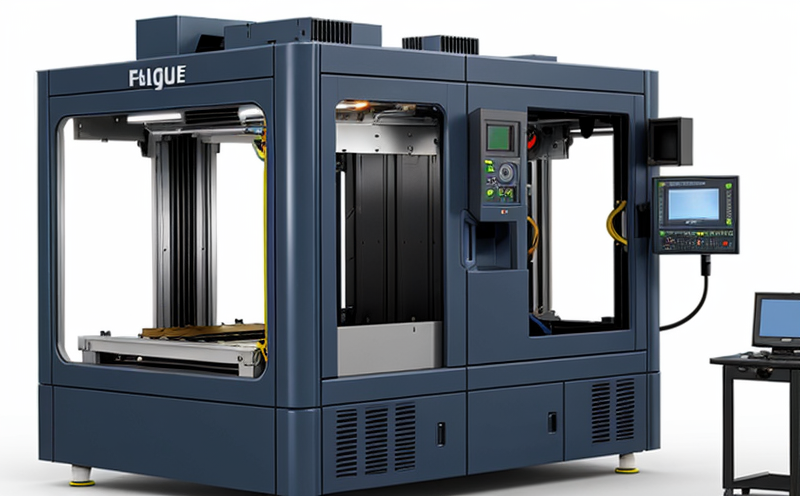ISO 12106 Strain-Controlled Fatigue Testing of Metals
The ISO 12106 standard provides a robust methodology for the fatigue testing of metals, particularly in additive manufacturing and 3D printing. This service is essential for ensuring that components meet stringent quality and reliability standards under cyclic loading conditions.
Strain-controlled fatigue testing involves applying controlled strain to a specimen until it fails due to repeated stress cycles. This method is preferred when the material properties are well understood, as it allows for precise control over the applied strains during the test. The process ensures accurate determination of the fatigue limit and endurance strength, which are critical parameters in assessing the durability of components.
For additive manufacturing (AM) and 3D printing, this type of testing is particularly important due to the unique microstructural properties that can vary significantly between different processes. By using strain-controlled fatigue testing, we can evaluate how these materials perform under cyclic loading, which is crucial for understanding their potential lifespan in real-world applications.
The test setup typically involves a servo-hydraulic machine capable of applying controlled strains to the specimen. The specimen is usually a specific geometry that represents the component's expected stress pattern during its lifecycle. The testing process is monitored using strain gauges and other sensors, which provide real-time data on the applied stresses and strains.
One key advantage of this method is its ability to simulate actual operating conditions more accurately than load-controlled tests. This is because it focuses on the material's response to stress rather than the external loading force, making it particularly useful for predicting fatigue life in complex geometries.
The process involves several steps: specimen preparation, mounting, applying controlled strain until failure, and data analysis. Specimen preparation is critical, as the microstructure must be representative of the final product. This may involve cutting coupons from larger parts or using specific additive manufacturing techniques to create test specimens.
Once prepared, the specimens are mounted in a fatigue testing machine that can apply controlled strains. The machine typically uses servo-hydraulic actuators to ensure precise control over the applied strain. The testing process is continuous, with the machine applying stress cycles until failure occurs. During this time, data on strain and stress is collected using various sensors.
The data analysis involves detailed examination of the test results to determine the fatigue limit and endurance strength. These parameters are critical for predicting the component's lifespan under cyclic loading conditions. The results are compared against industry standards such as ISO 12106, ASTM E935, and EN 14787.
For additive manufacturing and 3D printing, this testing method is particularly useful because it can reveal how the unique microstructures of these materials affect their fatigue performance. This information is invaluable for optimizing design parameters and ensuring that components meet stringent quality and reliability standards.
Industry Applications
| Industry Sector | Application |
|---|---|
| Automotive | Evaluating the fatigue performance of AM parts used in engine components and structural assemblies. |
| Aerospace | Determining the durability of 3D-printed components in aircraft structures and engines. |
| Medical Devices | Assessing the fatigue life of customized implants and prosthetics. |
| Rail Transportation | Evaluating the fatigue behavior of AM parts in rail carriages and rolling stock components. |
Eurolab Advantages
At Eurolab, we have extensive experience in fatigue testing, particularly with the ISO 12106 standard. Our state-of-the-art facilities and experienced staff ensure that our tests are conducted to the highest standards.
- Accurate Testing: We use advanced servo-hydraulic machines capable of precise strain control.
- Data Analysis Expertise: Our team has extensive experience in interpreting test data and providing actionable insights.
- Comprehensive Reporting: We provide detailed reports that include all relevant test parameters, analysis, and comparisons against industry standards.
- Custom Solutions: We offer tailored testing solutions to meet the specific needs of your organization.
Quality and Reliability Assurance
ISO 12106 strain-controlled fatigue testing plays a critical role in ensuring the quality and reliability of additive manufactured components. By simulating real-world loading conditions, this method helps identify potential weaknesses in the design or manufacturing process.
- Identify Weak Points: Detect flaws in material selection or processing methods that could lead to premature failure.
- Predict Performance: Estimate the expected lifespan of components under cyclic loading conditions, providing a basis for design improvements.
- Compliance Assurance: Ensure compliance with international standards such as ISO 12106, ASTM E935, and EN 14787.
- Data Validation: Validate the performance of new materials or processes against existing industry benchmarks.





